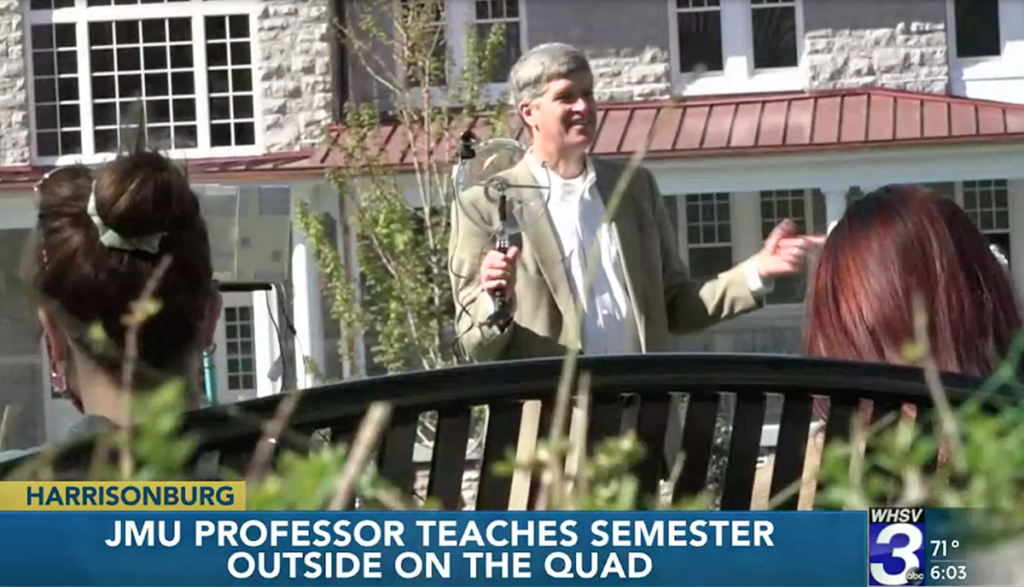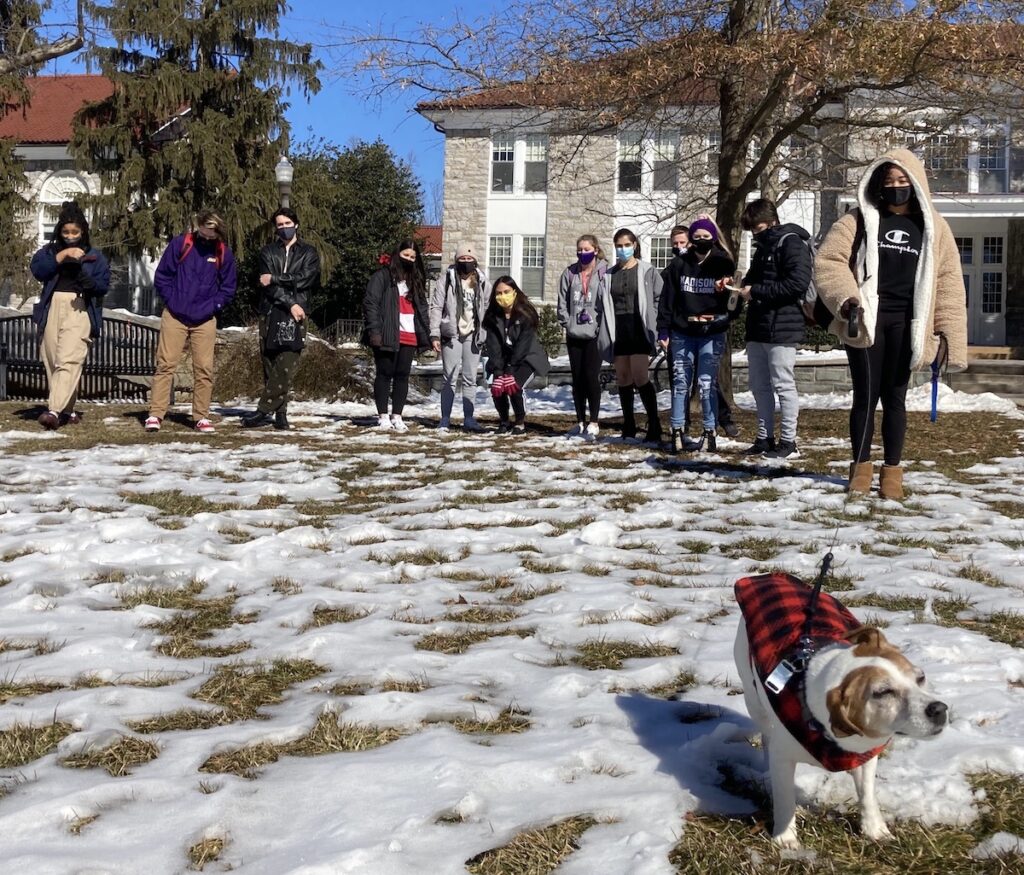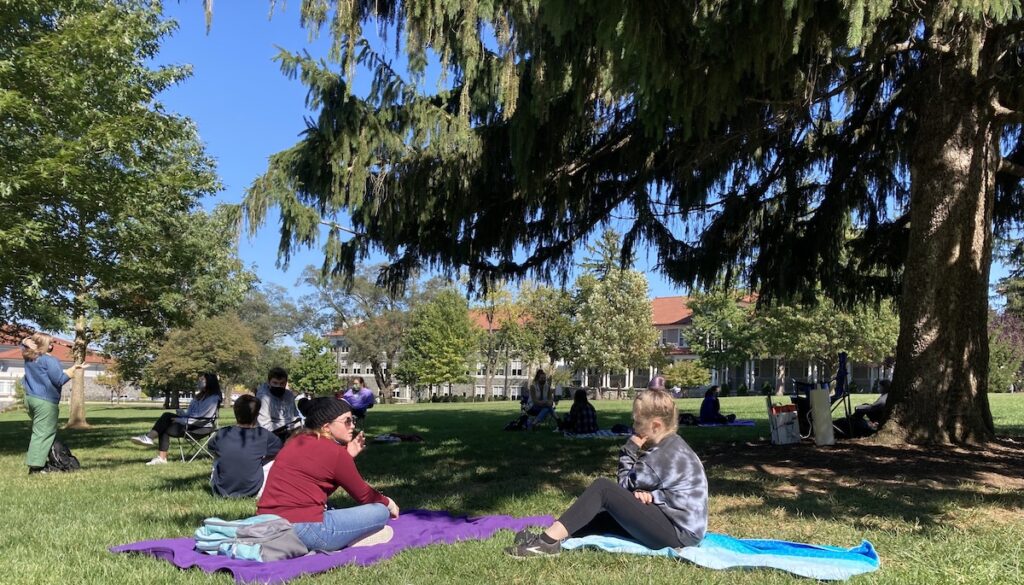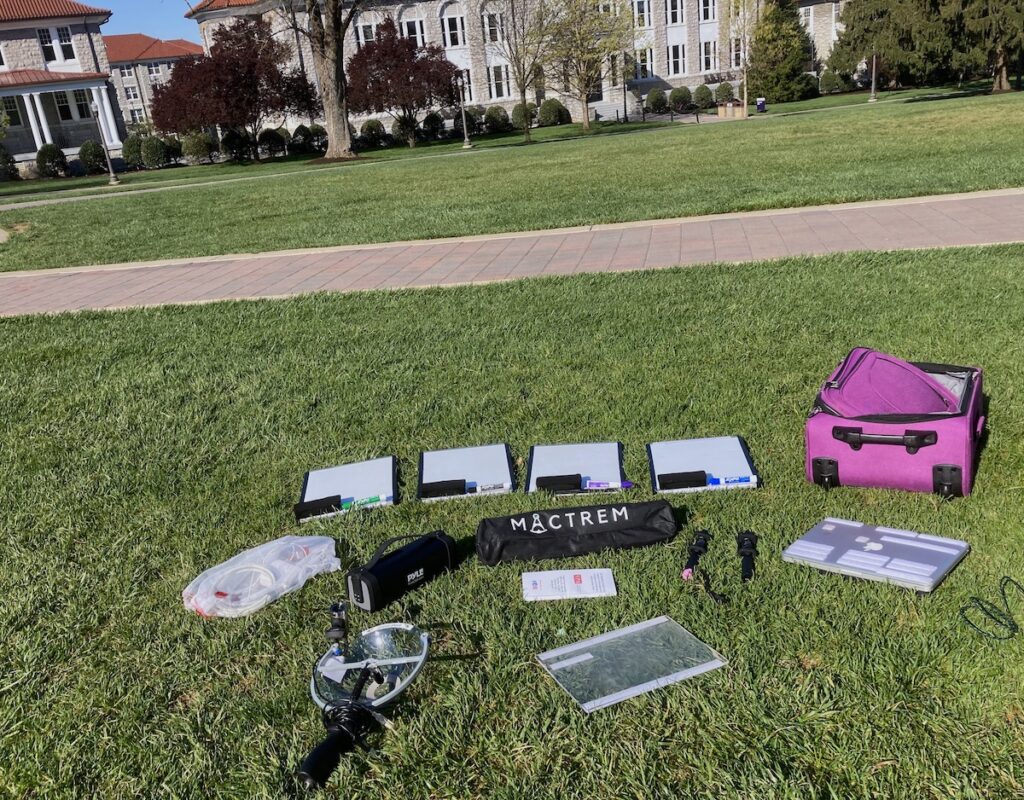We should have known that the return to teaching normalcy would be fraught with obstacles, and one of the biggest is the mask. The mask, along with its cohort, the plexiglas barrier, may be helpful in limiting transmission of airborne pathogens. However, these devices may also be limiting communication. They muffle voices, hide facial expressions, and generally deprive students and teacher of important visual cues. I can’t tell you how many times I’ve had to ask, “Hey, who was that who asked the question?”
But with the Delta variant rising, it’s hard to argue with safety mandates. It’s also hard to argue that, as long as these barriers remain in place, that in-person instruction suffers. After all, a cameras-on Zoom class usually conveys clear audio and identifies who is speaking, including an ever-present reminder of the speaker’s name.
There is, however, a way to get back to the traditional classroom– or should I say– the ancient classroom, the one that Plato might have known. What I’m talking about is the great outdoors.

“Impossible,” you say. “Too hot? Too cold? Too rainy? Too much effort?”
Before explaining how to deal with weather and other objections, let me tell you that during the 2020-21 academic year I taught 80 out of 110 class meetings out on the grass– or in a couple of instances the snow-covered grass. This was at James Madison University, which is located in the extremely variable weather of the Shenandoah Valley of Virginia.


Pandemic or not, your students will become more motivated and more educated when you teach outdoors, according to a 2013 longitudinal study in Sweden. Moreover, you can hold an array of interactive workshops that might be impossible within the confines of a classroom. For instance, we fired off a baking soda rocket, flew a kite, flipped fresh pancakes, and interviewed strangers.
At the same time that I taught outdoors, I also streamed my classes to those students who– because of work, family, or illness– chose to attend remotely. (Obviously, they did not get the full benefit of the pancakes.)
My outdoor HyFlex rig consists of off-the-shelf audio-visual components costing under $500. Toting them in a rolling suitcase and hooking them up is obviously an additional chore. But if you’re reading this, you are probably the kind of educator willing to take on additional chores to make learning compelling and accessible to your students during a pandemic, right?

I have put together a short (4.5-minute) YouTube video that gives a peek into my outdoor classroom.
There, you’ll notice what I **don’t** need: tents, specialized outdoor structures, or even chairs. My students bring their own folding chair or blanket. They are excited to learn outside, and the administration will likely be excited that you are finding a safe way of teaching through a pandemic– or any time.

When I first began teaching outside, I was thrilled to be channelling the spirit of Plato who taught at an Athens-area olive grove known as Akademia. But one of the first things I noticed was something that Plato and his students did not endure: lawn-mowing and leaf-blowing. The noise was distracting, but all it took was a single email to the head of facilities to get the petroleum-powered machines moved away from my class meetings. Temperatures would range from 37 to 95 that year, and we made snow angels one winter’s day– a day that, remarkably, saw 100% in-person attendance.
I could go into more specifics to coach you through your own outdoor experiment. But I’d like to leave you with the names of two recent pedagogy books that support parts of my program. One is “How Humans Learn” by Joshua Eyler, and it emphasizes the importance of seminars, which are what I’m conducting out there on the grass. (Yes, I flipped my classroom in order to teach outside.) The other book is “Minding Bodies” by Susan Hrach, and this one emphasizes the importance of movement, something my outdoor instruction and dynamic workshops accomplish.
Now that we are in what looks to be a long-term pandemic, some students are concerned about heading back into a classroom, and many professors are understandably fearful of entering a packed– or even a half-filled hybrid– classroom. Until my modern-day version of Akademia, the answer was forcing some students to stay home under the hybrid learning model, but outdoor HyFlex gives everyone a safe opportunity to learn synchronously in person or remotely.
As I write this blog post in the summer of 2021, there are concerns about new outbreaks of COVID-19 and its Delta variant. So the upcoming academic year seems poised for major challenges. Outdoor HyFlex may be the answer to these challenges.
The link below at Reason.com is my thumbnail rationale for outdoor teaching. I take the academy to task a bit, but obviously I think the criticism is justified: https://reason.com/2021/08/18/if-class-outside-was-good-enough-for-plato-its-good-enough-in-a-pandemic/
Dr. Spencer,
Thanks for providing the article and the link about teaching outdoors. I’m going to check out the books you mentioned too. So many commenters on Reason.com seemed to say that it can’t be done because of the weather. That is true, we do come up against some odds, but should that be a reason to dismiss your idea whole-heartedly? I don’t think so.
I believe instead of fighting against what exists, create something new to replace what no longer works (to paraphrase of R. Buckminster [Bucky] Fuller) and you seem to be offering that through trying something new (and old). Academia is in turmoil because the structures and processes upon which we’ve heavily relied no longer work. We’ve used the industrial model of education until there’s no one left in the factory! So why not try something new?
Hyflex asks instructors to break old habits and to be open to the unknown and to change. Your ideas take this one step further by saying Hyflex is not just for brick and mortar adaptations. It’s for everyone everywhere, no matter if they are sitting in the grass of the Quad, at their kitchen table, or at a desk in a classroom.
There are even more benefits in some cases that you didn’t mention – clean air (not filtered through old, used HVAC systems), sunlight for Vitamin D and other health benefits, and having an opportunity to practice focusing on one thing (the class) while so much is going on around you – look at the activity in the background of your video with lots of people going here and there and the campus clock chiming. Is this not like the work environment most of us face with so many distractions? I’m sure there’s even more to this revolutionary idea than these few things, for the natural world gives beyond what we can measure.
I want to add that it wasn’t just the ancient Greeks who taught while outdoors, many indigenous people learned and are still learning that way. One example – Dr. Robin Wall Kimmerer of SUNY ESF and Syracuse University here in New York. Consider her book, “Braiding Sweetgrass” in which she discusses how she often takes her students outdoors to enrich their knowledge of not only the natural world but of themselves. Self-knowledge is difficult to gain by most of our currently used academic means.
Hyflex is evolving to be more robust than anyone probably ever imagined. And this, I find, to be incredibly exciting to consider. May your ideas gain a foothold in that r/evolutionary process.
Regards, Susan
Thanks for such a thoughtful reply, Susan. Regarding the comments at Reason, I can’t worry about them because I have the sense that people are just flexing their pre-conceived notions. Even on a couple of ostensibly friendly Facebook groups to which I belong, people will just knee-jerk insist that hot/cold weather precludes outdoor learning without even reading the essay. The only reason that I can authoritatively say that imperfect weather teaching possible is because I’ve tried it. Thanks for mentioning the Vitamin D, the skill of focus, and other benefits that I forgot to mention– those are great points! BTW, I’ve got neither a Ph.D. nor even a masters, so no “Dr.” honorific for me. But thanks anyhow.